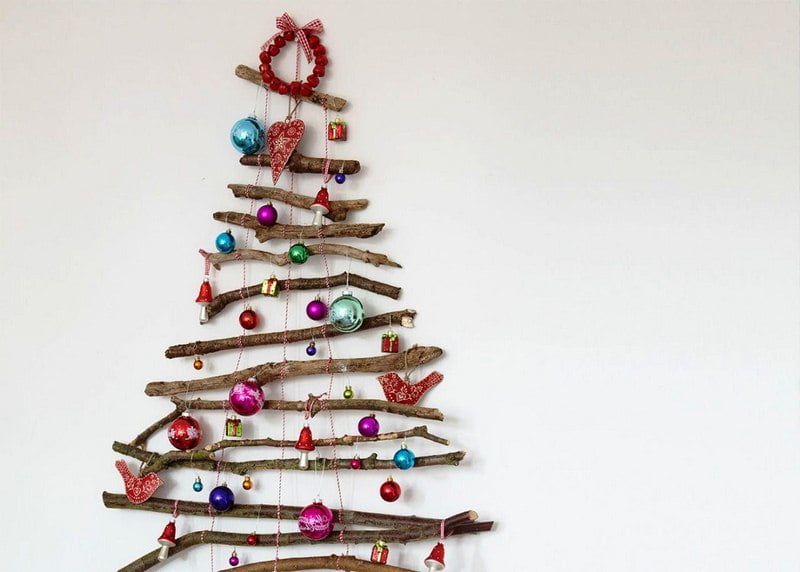Table of Contents Show
Making a twig tree can be a solo project, partner endeavor, or family adventure. While nature provides an endless storehouse of decorations, human imagination generates infinite combinations and variations.
The use of natural materials to create a Christmas twig tree in December can be the inspiration to adapt the tree for every season and reason throughout the coming year.
Framework for a Twig Tree
The framework for the twig tree is made of branches from trees and shrubs found on your property or on walks in the woods. The triangular frame requires three twigs. Two or three more twigs are needed to form crossbar branches for support.
Sturdy straight hardwood twigs with bark are best. The following specimens provide good twigs but experiment with what is in your surroundings:
- Birch
- Cherry
- Maple
- Oak
- Persimmon
- Pistache
- Sassafras
- Grapevines
The size of the framework depends on the space allocated for hanging the tree. For beginners, the manageable tree size is 36 inches tall.
Assembling the Twig Tree
Lay the three long sticks in a triangle on a clean flat surface indoors or outdoors. After deciding how large the tree will be, cut twigs to the desired lengths, allowing them to overlap an inch or two. Tie the twigs together at the three corners using a cord, fishing line, floral wire and tape, raffia, ribbon, rubber bands, twist ties, yarn, or wire.
Space, cut, and fasten the crossbars between the two vertical sides of the triangle. These branches add to the strength of the frame and provide additional space for decorations.
The tree framework should hold together firmly when held upright. Test hang the framework at its potential site.
Read Also:
Natural Materials for the Twig Tree
Use your imagination, ingenuity, and the natural materials at hand to make your first tree before branching out from there.
Start by taking a collecting walk across your property with pruning shears and baskets. Snip colorful cuttings from each of your most berried trees and shrubs like:
- Holly
- Nandina
- Photinia
- Pyracantha
- Wax myrtle
Snip cuttings from fine long-lasting broadleaf evergreen trees and shrubs specimens including:
- Acuba
- Boxwood
- Camellia
- Mahonia
- Magnolia
- Podocarpus
- Tea olive
Snip cuttings from conifers like:
- Arborvitae
- Juniper
- Pine
- Spruce
Take cuttings from evergreen vines:
- Ivy
- Smilax
Collect decorative structures from the following:
- Crepe myrtle seed pods
- Golden rain tree pods
- Groundsel shrub pappus
- Lunaria pods
- Milkweed pods
- Pinecones
- Sweet gumballs
- Sycamore balls
Trimming the Twig Tree
There are many ways to trim the tree. One way is to space clusters of the most colorful foliage and berries at all of the angles of the triangle and cross branches. Then fill in the bare spaces with greenery and pods. The flexible vines can be wound around the twig surfaces.
Or, twine plant material around the framework first. Evergreen vines work well for this. Once the frame is covered in the vine, berries or pods are hung to dangle from the crossbars.
Having the framework on a flat surface allows you to arrange, rearrange, and tweak your design before fastening it all with string or yarn for the final display.
Experiment with a variety of materials and hanging methods. Herb gardeners tie small bundles of dried or fresh herbs like rosemary, oregano, thyme, and sage to the frame.
Flower gardeners make an everlasting twig tree with bundles of dried flowers including babies’ breaths, candytuft, celosia, globe amaranth, hydrangea, lavender, statice, strawflower, and yarrow.
If the twig tree’s destination is a kitchen, then garlic, dried peppers, and dried ears of strawberry popcorn are appropriate decorations.
Another scent for a Christmas twig tree is citrus. Make dried lemon, lime, and orange pinwheel ornaments sprinkled with cinnamon or studded with cloves and hung from the crossbars with ribbon.
Variations on a Twig Tree
The twig tree is an excellent activity for students learning to identify plants and plant parts. The activity also is one to teach elements of design in art class.
The simple triangle twig tree design with the use of scented natural materials is an activity visually impaired students can successfully participate in.
Making twig trees is a fun and frugal activity for families and for children’s parties. Provide the tools, twigs, and materials for guests to make their own twig trees to take home to hang.
Whether you make a twig tree as an alternative to an evergreen Christmas tree or an additional holiday decoration, it is a versatile natural craft for all ages and many occasions throughout the New Year.
Sources
- Haynie, Don. “Christmas Crafting.” The Herb Companion. December/January 1995/1996. pgs. 60-63.
- LeVan, Marthe. Nature Style. New York: Lark Books, 2002.

